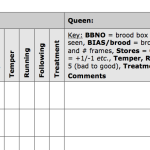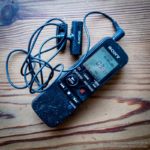Beekeeping records - part 2
The importance of beekeepng records for the week to week management of colonies is undeniable, as discussed in the previous piece on this subject. However, they’re also useful when making comparisons over a longer time period. For example, I raised some queens a few years ago from a genetically distinct queen introduced to my stock. The bees were well tempered and good to work with. However, in comparisons over the following 12-24 months – where I had good records of the provenance of the queens – it was clear that this particular line struggled with chalk brood when the colonies were small or stressed. Almost all the daughter queens were like this … and in due course all were replaced. Similarly, if the notes you keep includes details of available forage – when the OSR went over, when the blackberry started or how well the himalayan balsam yielded – you can get an idea of what to expect in future years.
How to keep the records and, to a lesser extent, where to keep them is the next problem. This is where I sometimes struggle. I’ve got the records, but not always in a readily useable format or location. I’m getting better and have a system that more-or-less works now, but it’s not foolproof.
Digital or analogue?
I’m aware of a few smartphone applications designed to keep hive records. One is Beetight (web, iPhone, Android) and another is HiveTracks (similar platforms I think; the website contains the quote “a buck a month a hive” … and they ‘manage’ nearly 100,000 hives!). It’s also possible to keep hive records on BeeBase these days, but the interface is clunky. I’ve not tried any of them seriously I’m afraid. I’m not usually a luddite where technology is concerned but am apprehensive about committing to these purely digital methods for two reasons:
- Data input. I know what I want to record, so don’t want to be ignoring superfluous (to me, perhaps not to others) fields when entering data. Therefore the interface to the database needs to be easily customisable. Although this is already possible with some applications it still leaves a problem with the input part of data input. I don’t want to be tapping away at my mobile screen while surrounded by clouds of bees, or sticky with propolis. The combination of fat fingers, failing eyesight and bright sunshine (the norm in Fife 😉 ) gives me a headache when composing text messages … not an experience I want to replicate during a relaxing morning of beekeeping.
- Data backup and recovery. Where are the digital records stored and in what format? If they’re on the phone and I lose/change/break it I’m scuppered. If they’re on ‘the cloud’ (not that we have any of those in the Kingdom of Fife 🙂 ) then they’re nominally safe and accessible, until the application is no longer supported, or the apiary has no mobile signal. I use databases for work and have a reasonable knowledge of SQL but I still don’t want to have to manually extract sqlite records to recover old beekeeping notes. If BeeNotes™ goes belly-up after their KickStarter project fails to generate the $250,000 startup funding you’re scuppered … and if you have no idea what SQL, sqlite or KickStarter are then follow my example.
Use pen and paper.
Where to keep the records
Hive records are generated in the field but are needed when you’re preparing to go to the apiary (i.e. at home … or wherever you keep your spare equipment) so you remember the super/dummy board/frame you made careful notes about last time. They’re also needed just before you open the hive, so you have an idea of what might be happening, what needs to be done or what to look out for – does the queen in this box need marking and clipping this time?
Some beekeepers keep records tucked under the hive lid above the crown board. If you do this either use solid crownboards or keep them in a plastic envelope, or the bees might chew them. However, if stored under the hive roof they’re not available at home where your spare equipment is stored. Others write notes on scrap paper as they inspect, transferring them to a permanent record once they get home (or – and I write here from extensive experience – forget to do this having filed them in the glove compartment of the car, or under a pile of papers in the kitchen). I’ve tried both approaches, but have ended up with a compromise solution that saves losing the scrappy notes before they’re deciphered and doesn’t necessitate writing things twice. Some critical notes still get written directly into the hive roof using a queen marking pen; “QC sealed on Thur 17/5” for example. The black Correx roofs I make are particularly good for this. However, remember that roofs aren’t permanent fixtures … they can easily be swapped during inspections with potentially unintended consequences.
Say what you mean

Hive record card …
I keep my written records on A4 sheets in a ring binder, with one sheet per colony. I can usually get a full year of inspections onto a single page. The table is headed with some brief instructions and boxes to record the apiary, hive number and queen provenence (if known). After that each row has space to record the date and the characteristics of the colony – queen status, brood, temper, steadiness on the comb, treatment and notes (see template). Rather than fill this in when I’m in the apiary – possibly struggling with propolis-covered gloves on a windy day for example – I use a small digital voice recorder to take the notes.

Talk to me …
After completing an inspection and closing the hive I just need to push the record button and make a quick comment … “Brunton apiary, hive 3, queenright, white, marked clipped, laying, 8 frames of BIAS, some chalkbrood, temper 4 but running a bit much, needs a QE and super next time”. I usually do this having gently smoked the next colony entrance, leaving them time to settle before opening the hive. This process takes less time to record than to read and is saved in a folder on the machine with all the other inspection records of that day. Most mobile phones have a similar voice recording facility but I already have enough trouble seeing the screen in bright sunshine without inevitably adding a smear of propolis.

Update the notes …
On returning from the apiary – probably after a full morning inspecting colonies in several apiaries – it’s an easy task to transcribe the notes onto the hive record sheets with a mug of tea for company. My digital recorder has a simple Play/Pause button, so I can whizz through the recording, one hive at a time, making the relevant jottings in the file. However, if I forget to (or don’t have time to) I still have the dated verbal records I can recall whenever needed … no scraps of paper to misplace or to get mangled when the beesuit goes through the wash. Then, before setting off for the apiary the following week I can quickly read through the last line or so of notes for each colony, making a mental note of what to be alert for and ensuring I have the relevant pieces of kit with me. During peak season, when there’s a lot to remember (or forget!), the hive records book goes in the car with me to the apiary.
For the first couple of seasons I kept the recorder in a plastic bag to protect it from propolis. The Pause/Record button is big enough to use with gloves through a bag. However, the bag was ‘re-purposed’ to collect some blackberries or something like that and was never replaced. It’s now a bit tacky on a warm day but works perfectly well. A couple of AAA batteries lasts ages and newer models have a rechargeable lithium battery which would be even better. These small digital recorders have some fancy features which almost always include voice-activated recordings. These detect pauses in speech and stop recording. I’ve never had this work satisfactorily in the apiary and have given up trying. Usually the machine would never pause because of the ambient noise level – bees buzzing about, wind in the bushes – leaving 10 minute intervals of me inanely muttering as I pottered about the apiary or returned to the car to collect things I’d forgotten.
Believe me, these don’t make entertaining listening … “Hmmm, hive tool? Where’s the damned hive tool? … was that a partridge calling? … mutter, mutter … seconds frames, poor investment … what an enormous slug … [extended period of bees buzzing frantically] … [out of tune singing]” and so on.


Join the discussion ...